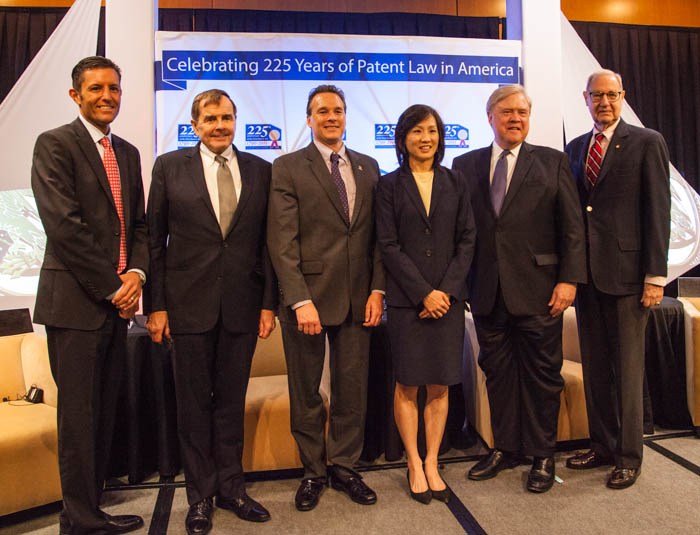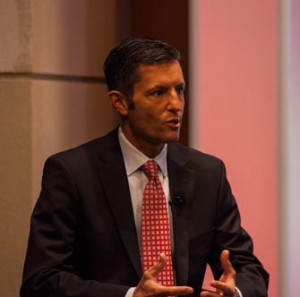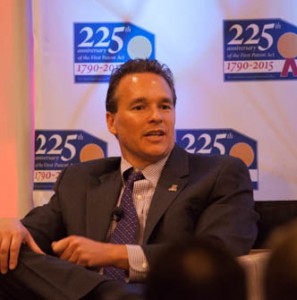
Left to Right: Louis Foreman, Bruce Lehman, Jon Dudas, Michelle Lee, Todd Dickinson, Gerry Mossinghoff.
On April 10, 1790, President George Washington signed into law the third Act of Congress, otherwise known as the Patent Act. So important was it for the new nation to establish a patent system that President Washington devoted a portion of his exceptionally brief first-ever State of the Union address to imploring Congress to immediately pass the legislation, the importance of which he explained was self evident.
Fast-forward 225 years to April 10, 2015. The United States Patent and Trademark Office (USPTO) celebrated the occasion with a panel of former leaders of the Patent Office. The discussion was moderated by Louis Foreman, publisher of Inventor’s Digest and producer of Everyday Edison’s on PBS. The panel included the newly sworn in current Director Michelle Lee, as well as former Directors Jon Dudas and Todd Dickinson. Also present were former Commissioners, the previous top position at the USPTO, Bruce Lehman and Gerald Mossinghoff.
During a free-flowing conversation the former leaders of the Patent Office agreed on a number of items, including the biggest problem for the Patent Office over the last generation: fee diversion. Both Dickinson and Mossinghoff pointed to fee diversion as a constant and continuing challenge. Dickinson recalled one particular budget where nearly $250 million was diverted from the Patent Office budget, a huge sum given that at the time the USPTO annual budget hovered around $1 billion.
Mossinghoff explained that he had the benefit of a White House that wanted desperately to streamline the patent process and decrease application pendency. Indeed, President Ronald Reagan himself pushed the Patent Office to be able to reach 18 months average pendency by 1987. “The President promised 18 months by ’87,” Mossinghoff said. “We didn’t do it by ’87, but we did do it by ’89.” Mossinghoff attributed the ability to reach 18 months average pendency due to buy in of the President, which meant there would be sufficient resources to do the job. ” Getting the President to agree to a fully funded Patent and Trademark Office did wonders while I was running the Office,” Mossinghoff explained.
“When I came in we were feeling all the effects of the increase in patent applications without any increase in the number of patent examiners” Dudas explained. Dudas’ meetings with Congress did not go well, with those on the Hill simply not in favor of the USPTO “hiring their way out of the problem.” Ultimately the USPTO would begin hiring 1,200 examiners a year while Dudas was Director, with current Commissioner for Patents Peggy Focarino in charge of hiring the new examiners.
Forman moved the question from the biggest challenge to the biggest change, asking: “What would you say is the biggest change during your time in office?”
Dudas did not directly answer the question, but he did say, “change is like fresh water in a stagnant pool… the people here embrace change. Changing hasn’t been a problem for the Patent and Trademark Office, the people here embrace change.”
“By and large change is often good, when it is well managed,” Dickinson said. He then pointed out that the biggest change during his tenure was the rapid use of information technologies and computers. “I finalized putting the patent database online… required patent examiners to search online. State Street in particular caused a huge avalanche of applications.”
“Whether change is good or bad it happens,” Lehman explained. “The biggest change was the globalization of the IP system… this is when we finalized the TRIPS agreement… which created a harmonious system to recognizes rights… The Internet as we know it didn’t exist because the Internet as we know it is the World Wide Web… so the Internet literally did not exist.”
“During Bruce’s tenure there were 7 treaties,” Dickinson explained. “Since that time we really haven’t been able to do anything to forward substantive harmonization.”
Mossinghoff — He would sometimes tell the Secretary if you make me do X then I won’t be able to meet the President’s goal of 18 by ’87. There would be meetings and the next day we would be allowed to do what we needed to do.
Foreman’s next question was simply to ask: Why did you decide to accept the offer to lead the Patent Office?
“It was a lot of work, but I can’t think of anything I’ve ever done, including NASA, that was more satisfying than what we were able to do at the Patent Office,” Mossinghoff explained.
“I lobbied to get President Clinton to appoint me because my passion was government service and public policy,” Lehman explained. “That is what I wanted to do my whole life and this was the apogee.”
“When Mr. Lehman called me to see if I would join him I said yes for a variety of reasons,” Dickinson explained. “I believed it would give me an opportunity to make a difference.” Dickinson went on to recount how each week there were decisions that only he could make. “They would come in once a week with 9 or 10 things that only I could decide. It was very liberating to go through the exercise to get it right,” Dickinson said. “Sometimes we would go around the table and vote before I would make my decision.” Dickinson then told a story about Rule 99. “I wanted to expand opportunities for people to submit prior art. So we voted and the vote was 15 to 1 against implementing the rule, but we did implement it.”
“Having seen, from a Congressional perspective, so many different agencies I didn’t think there were any other place in government that I could have as much impact,” Dudas explained. “Once you are here it is incredibly energizing… everybody gets behind what they need to get done.”
“I never thought I would be in Washington, DC, 3,000 miles away from where I consider home,” Lee answered. Lee would then go on to say that if you have gained a perspective that might be useful and “someone asks you to serve I think you have an obligation to serve if you can do it.”
Foreman took the session toward a discussion of current events, asking: “Why is there an anti-patent sentiment?” Initially no one seemed to want to take the question. Indeed, it seemed there was an awkward silence for longer that it probably was in real time. But it didn’t seem like anyone wanted to touch the question. Eventually Lehman answered, saying “during the Clinton Administration you couldn’t really say anything bad about intellectual property, but now the pendulum has swung back,” recognizing that is how the system and laws generally tend to go.
“There is a divergence of interest,” Dickinson explained. “A public relations campaign… has changed the system in ways that may not be for the best.”
Then Dudas answered the question directly, without pulling any punches. “What is the reason for anti-intellectual property sentiment? I’ll give you two words: greed and ignorance,” Dudas answered. “If you are against intellectual property is has to be because of greed or ignorance.”
Director Lee took the opportunity to say that rights that are too strong can inhibit innovation, saying: “There is a range in which it is optimal to operate… I spend a lot of time making sure we end up in that range.”
Mossinghoff used the question to discuss recent Supreme Court decisions. “I’m concerned that we are perhaps moving back to an unfriendly Supreme Court, starting with the Alice decision, which is causing cases to be dismissed without discovery,” Mossinghoff explained. “I think the Alice decision has created all kinds of problems for patent attorneys and their clients who use the patent system… [the Supreme Court] is taking more cases and their decisions are not helpful to the patent system, in my opinion.”
A question from one of the regional offices, who were attending via web conference, asked what advice the former leaders had for Director Lee. “I think at the head of the job description for any director of any agency is try to get the money,” Mossinghoff explained.
“My advice is to go to the USPTO gym,” Dudas explained. “At the USPTO gym you will be amazed by the advice that you get from colleagues that they would never approach you to tell you, or never say in any meeting… so I would say go to the gym, but you don’t have to workout.”
John Cabeca, Regional Director of the Silicon Valley Office, asked the panel what they think we will be celebrating at the 250th anniversary?
“My first hope is that I’ll be there,” said Mossinghoff, who then pivoted to say that by moving to first to file there is a real opportunity to have a single examination worldwide, which could be the big development over the next generation. Dickinson echoed the sentiment, saying: “I hope we will be celebrating further advance on substantive harmonization.” Lehman similarly pointed overseas to the PPH “creating a de facto global Patent Office.”
“When a company can be on the Internet and have their first sale in Bejing as easy as it could be in Boston I think there will be enormous business pressure to harmonize substantive and procedural laws,” Lee answered.
To wrap up the event questions from the audience were solicited. One question pointed to the fact that the rest of the world files more in the US than US individuals and corporations. “Does that mean that innovation is in decline in the US?”
“There is no decline in the innovation community,” Lee answered. “I do not see any signs of decrease in innovation.” Dickinson echoed this, pointing out that US filings have not decreased, but rather “it seems that the rest of the world has continued to see the value of US patents.”

![[IPWatchdog Logo]](https://ipwatchdog.com/wp-content/themes/IPWatchdog%20-%202023/assets/images/temp/logo-small@2x.png)





![[Advertisement]](https://ipwatchdog.com/wp-content/uploads/2024/04/Artificial-Intelligence-2024-REPLAY-sidebar-700x500-corrected.jpg)
![[Advertisement]](https://ipwatchdog.com/wp-content/uploads/2024/04/Patent-Litigation-Masters-2024-sidebar-700x500-1.jpg)

![[Advertisement]](https://ipwatchdog.com/wp-content/uploads/2021/12/WEBINAR-336-x-280-px.png)
![[Advertisement]](https://ipwatchdog.com/wp-content/uploads/2021/12/2021-Patent-Practice-on-Demand-recorded-Feb-2021-336-x-280.jpg)
![[Advertisement]](https://ipwatchdog.com/wp-content/uploads/2021/12/Ad-4-The-Invent-Patent-System™.png)






Join the Discussion
10 comments so far.
Night Writer
April 29, 2015 11:23 pmWhat still gets me about all this is how absurd the “reform” nonsense is. I don’t trust Lee for a second. I think any chance she gets to weaken patents she will jump on. Not only that but the people talking about this are so far removed from reality it is ridiculous. The fact is that prosecution could be vastly improved with modern big data solutions. And so much of the problems are now the PTO trying to adhere to the new SCOTUS cases which basically boil down to: does the fact finder like you and your patent.
The whole thing is just nonsense.
Anon
April 29, 2015 11:09 pmAs to calling it a solvable problem that should be solved…
…I thought I did that. 🙂
Night Writer
April 29, 2015 10:42 pmOK. OK. Anon. We won’t call it the biggest problem, but sheesh (!) how about calling it a solvable problem that should be solved. (Or just pass the new legislation and burn the patent system down and the PTO with it.)
Anon
April 29, 2015 08:48 amNight Writer @ 5,
Again I would disagree as to the use of the term “biggest.”
There can be only one “biggest,” and the fees – to my mind – simply do not supplant other problems for that one spot.
Further, there is nothing currently stopping the annual mechanism from incorporating multi-year analysis and forecasting given that the whole of the examination process necessarily spans multiple years. The fact that a budget process is undertaken year by year does not necessarily preclude the multi-year analysis and fee setting.
Anon
April 29, 2015 08:44 amApologies a forehand for the duplicate post – here and on the “Biggest Problem Thread”….
One comment that I find troubling from Miss Lee is the comment geared to a “too powerful” patent.
“Director Lee took the opportunity to say that rights that are too strong can inhibit innovation, saying: ‘There is a range in which it is optimal to operate… I spend a lot of time making sure we end up in that range.’”
Such a view can only be made with hindsight, and with subjectivity , or conversely, with “objectivity” of market effects (again hindsight).
This strays away from the truly objective role of the Office to examine according to the law. If that is achieved, then it truly matters not whether a granted patent is “too powerful,” as the benefit of the benefit of the patentee’s contribution will be in equal measure to the power of the patent.
The focus should be on Quid Pro Quo, and the “notion” of “too powerful” will take care of itself.
This thought of somehow (subjectively) impacting future innovation by granting a patent that is “too strong” is offensive in several ways, not the least of which is that it assumes future harm (which by its nature cannot be shown), and is reflective of a judicial fallacy which violates the “no advisory opinions” rule of law, as well as the basic notion of a present case or controversy or even a (related) cause for present standing – since no present party can be said to have already suffered this supposed harm of “future”-being-blocked. The Supreme Court is fond of taking shots at the patent bar for our work as “scriviners.” Perhaps it is time that their own “scrivining” is “judged” just as critically.
Night Writer
April 29, 2015 07:48 amI think the fee diversion is the biggest problem. It makes it so the PTO is constantly scrambling for money. Bad idea. The PTO should have a more predictable source of money and should be able to charge fees that contemplate the costs that may extend past a year.
Anon
April 28, 2015 09:53 pmGene,
You missed the tense of my sentence – I did not use past tense (as in fixed).
“Can be” – is that future perfect tense….? (one can always hope that this answer – the permanent one – comes to pass)
Gene Quinn
April 28, 2015 03:53 pmAnon-
I think you assume too much when you say that this is a problem that is fixed. Immediately after the so-called fix in the AIA the Congress started considering more fee diversion. The fix is not binding. The PTO is still governed by appropriations. There is no guarantee that the PTO will get to keep and use all collected fees. That is why there have been a number of permanent legislative fixes submitted this year, including in the STRONG Patents Act and in the Innovation Protection Act.
-Gene
Ned Heller
April 28, 2015 02:03 pmMay I suggest that whatever the backlog, if the PTO issues patents that are invalid in large numbers, patents whose claims are unclear if not legally indefinite, patents that claim results, not inventions, patents that literally read on whole swaths of industry while contributing little or no advance, then the PTO bears in large measure co-responsibility for the so-called troll problem that vexes today’s America. Focusing on process, backlog, budgets, infrastructure at the expense of not focusing on job number one is the reason that the PTO has brought IP into disrepute.
Anon
April 28, 2015 11:19 amIs it a problem?
Yes
Is it a big problem?
Yes
Is it a problem that is readily fixed?
Yes
Is it “the biggest” problem?
Most definitely not.
Everything in moderation – even hyperbole.